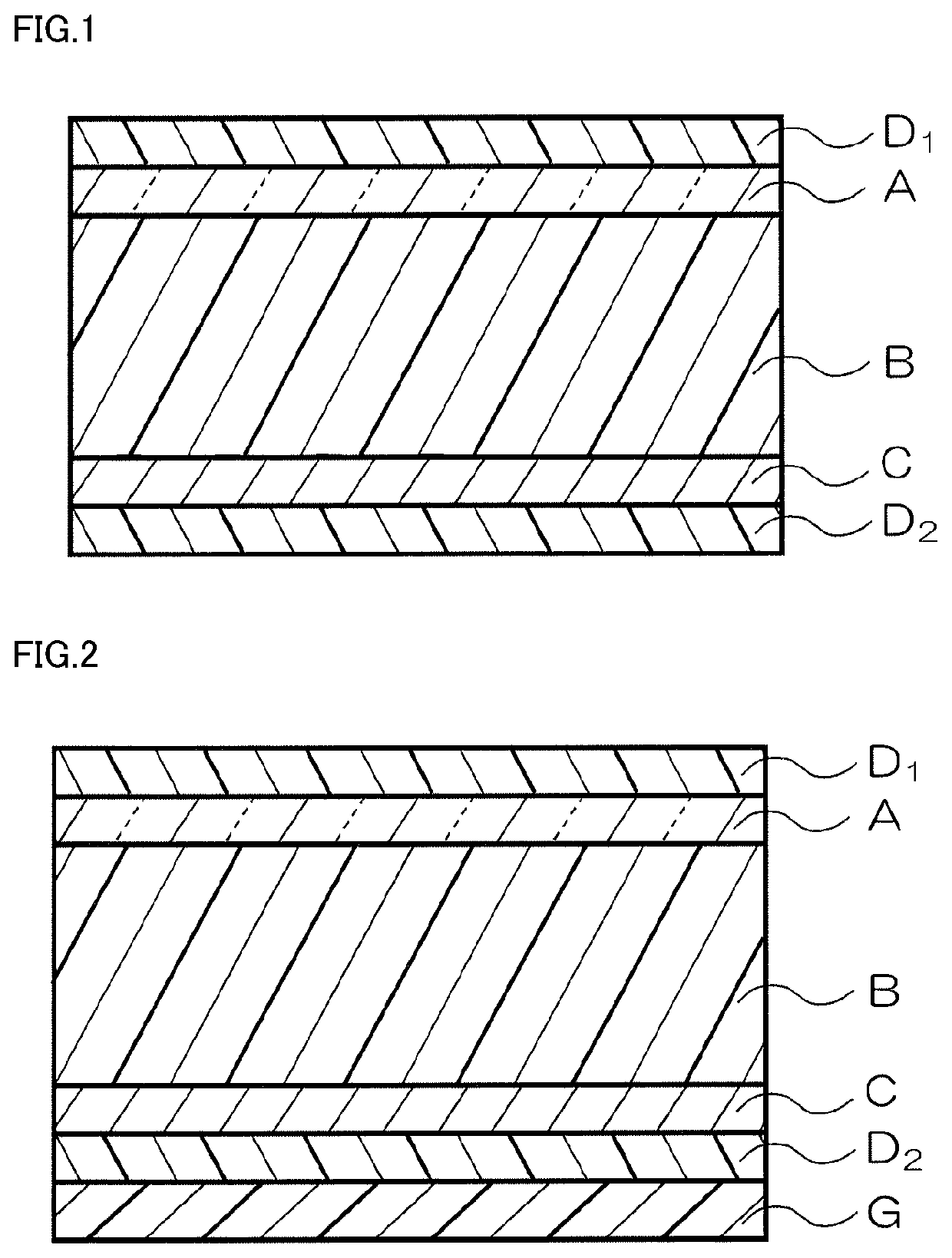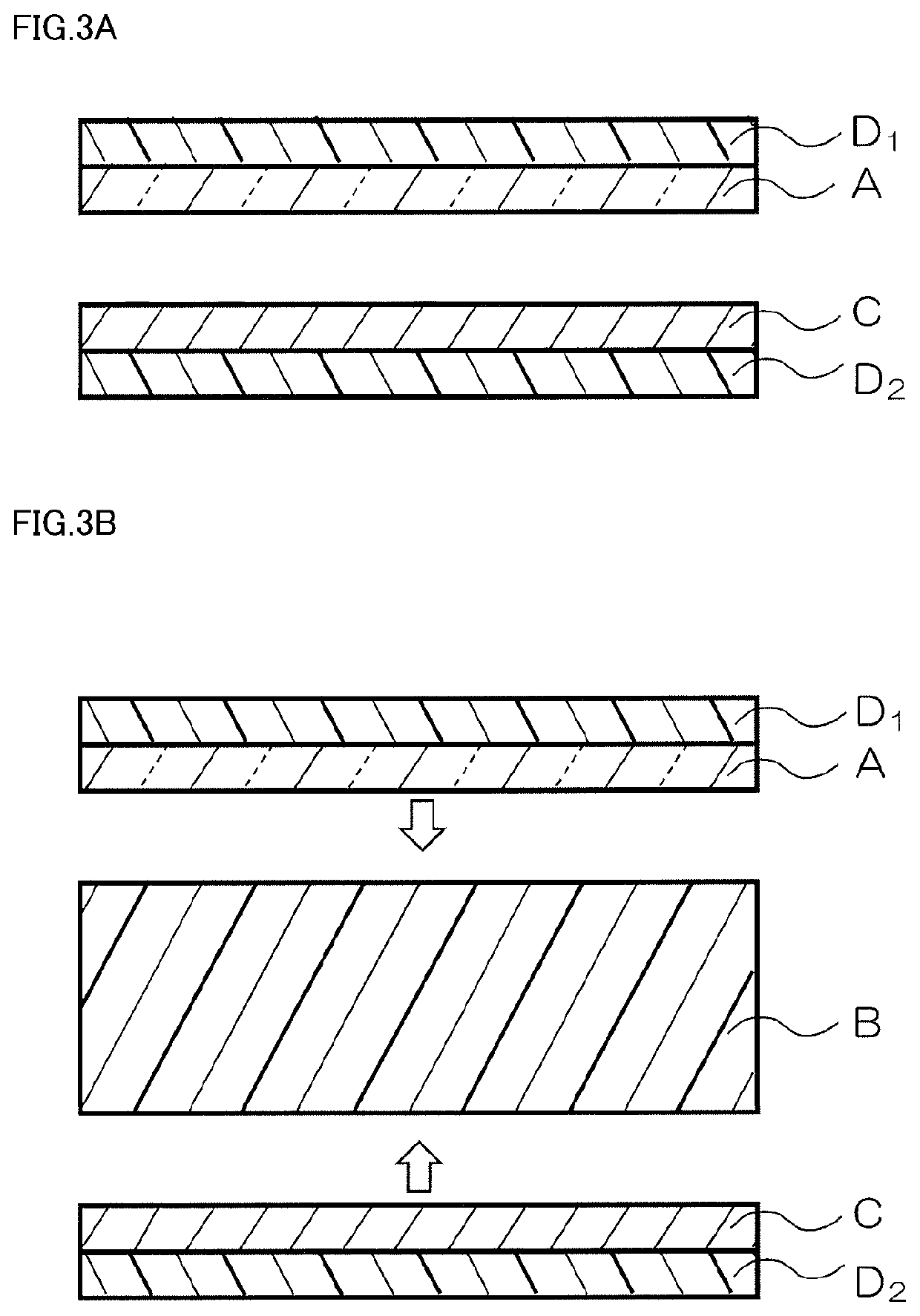Electromagnetic wave absorber
a technology of electromagnetic absorbers and absorbers, which is applied in the field of electromagnetic absorbers, can solve the problems of inability to provide sufficient absorption performance at a set frequency, inability to cover high frequency bands, and limited range of conventional electromagnetic absorbers, so as to achieve uniform electromagnetic wave absorbing effect, widen absorption bandwidth, and widen absorption bandwidth
- Summary
- Abstract
- Description
- Claims
- Application Information
AI Technical Summary
Benefits of technology
Problems solved by technology
Method used
Image
Examples
##ventive example 1
Inventive Example 1
[0058]Pursuant to the method of providing the electromagnetic wave absorber shown in FIG. 1, an EVA resin (Evaflex EV250, with a relative dielectric constant of 2.45) available from Du Pont-Mitsui Polychemicals Co., Ltd. was pressed at 120° C. into a film having a thickness of 560 μm. Thus, the dielectric layer B was produced. A PET film (resin layer D1) having a thickness of 38 μm on which ITO serving as the electrically conductive layer C was sputtered so as to have a surface resistance of 20Ω / □ was affixed to a second surface of the dielectric layer B so that the electrically conductive layer C faced the dielectric layer B. A PET film (resin layer D2) having a thickness of 38 μm on which. ITO serving as the resistive layer A was sputtered so as to have a surface resistance of 380Ω / □ was affixed to a first surface of the dielectric layer B so that the resistive layer A faced the dielectric layer B. Thus, an intended electromagnetic wave absorber was provided.
##ventive example 2
Inventive Example 2
[0059]Pursuant to the method of providing the electromagnetic wave absorber shown in FIG. 1, an intended electromagnetic wave absorber was provided in substantially the same manner as in Inventive Example 1 except that the dielectric layer B was changed to that to be described below.
[0060](Dielectric Layer B)
[0061]The dielectric layer B was produced by adding 50 parts by weight of barium titanate (BT-01) available from Sakai Chemical Industry Co., Ltd. to 100 parts by weight of an EVA resin (Evaflex EV250) available from Du Pont-Mitsui Polychemicals Co., Ltd.; kneading the resulting mixture in a mixing mill; and then pressing the kneaded mixture at 120° C. into a film having a thickness of 458 μm. The dielectric layer B had a relative dielectric constant of 3.90.
##ventive example 3
Inventive Example 3
[0062]Pursuant to the method of providing the electromagnetic wave absorber shown in FIG. 1, an intended electromagnetic wave absorber was provided in substantially the same manner as in Inventive Example 1 except that the dielectric layer B was changed to that to be described below.
[0063](Dielectric Layer B)
[0064]The dielectric layer B was produced by adding 100 parts by weight of barium titanate (BT-01) available from Sakai Chemical Industry Co. Ltd. to 100 parts by weight of an EVA resin (Evaflex EV250) available from Du Pont-Mitsui Polychemicals Co, Ltd.; kneading the resulting mixture in a mixing mill; and then pressing the kneaded mixture at 120° C. into a film having a thickness of 397 μm. The dielectric layer B had a relative dielectric constant of 5.19.
PUM
| Property | Measurement | Unit |
|---|---|---|
| relative dielectric constant | aaaaa | aaaaa |
| thickness | aaaaa | aaaaa |
| frequency | aaaaa | aaaaa |
Abstract
Description
Claims
Application Information
 Login to View More
Login to View More - R&D
- Intellectual Property
- Life Sciences
- Materials
- Tech Scout
- Unparalleled Data Quality
- Higher Quality Content
- 60% Fewer Hallucinations
Browse by: Latest US Patents, China's latest patents, Technical Efficacy Thesaurus, Application Domain, Technology Topic, Popular Technical Reports.
© 2025 PatSnap. All rights reserved.Legal|Privacy policy|Modern Slavery Act Transparency Statement|Sitemap|About US| Contact US: help@patsnap.com



